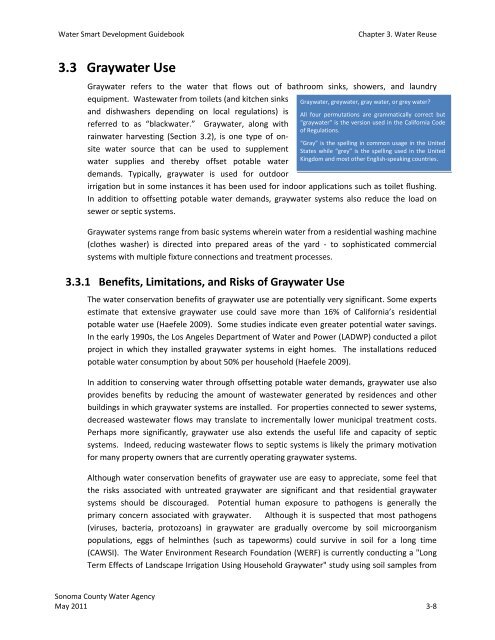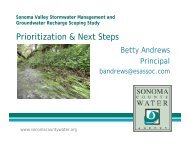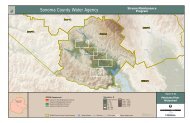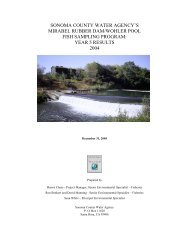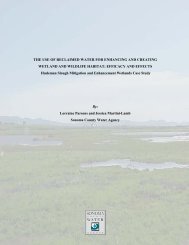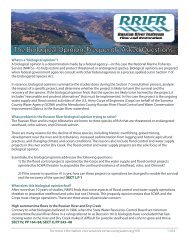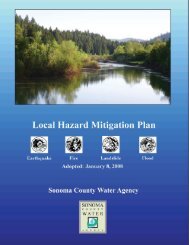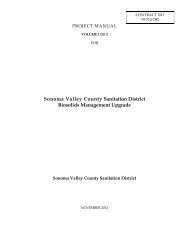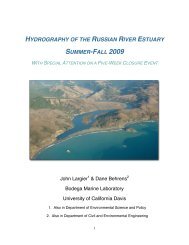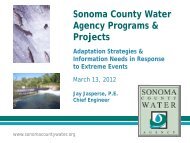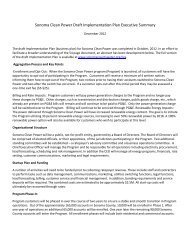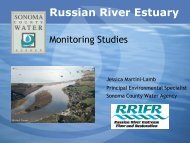Chapter 3 Water Reuse - Sonoma County Water Agency - State of ...
Chapter 3 Water Reuse - Sonoma County Water Agency - State of ...
Chapter 3 Water Reuse - Sonoma County Water Agency - State of ...
Create successful ePaper yourself
Turn your PDF publications into a flip-book with our unique Google optimized e-Paper software.
<strong>Water</strong> Smart Development Guidebook<br />
<strong>Chapter</strong> 3. <strong>Water</strong> <strong>Reuse</strong><br />
3.3 Graywater Use<br />
Graywater refers to the water that flows out <strong>of</strong> bathroom sinks, showers, and laundry<br />
equipment. Wastewater from toilets (and kitchen sinks<br />
and dishwashers depending on local regulations) is<br />
referred to as “blackwater.” Graywater, along with<br />
rainwater harvesting (Section 3.2), is one type <strong>of</strong> onsite<br />
water source that can be used to supplement<br />
water supplies and thereby <strong>of</strong>fset potable water<br />
demands. Typically, graywater is used for outdoor<br />
Graywater, greywater, gray water, or grey water?<br />
All four permutations are grammatically correct but<br />
“graywater” is the version used in the California Code<br />
<strong>of</strong> Regulations.<br />
“Gray” is the spelling in common usage in the United<br />
<strong>State</strong>s while “grey” is the spelling used in the United<br />
Kingdom and most other English‐speaking countries.<br />
irrigation but in some instances it has been used for indoor applications such as toilet flushing.<br />
In addition to <strong>of</strong>fsetting potable water demands, graywater systems also reduce the load on<br />
sewer or septic systems.<br />
Graywater systems range from basic systems wherein water from a residential washing machine<br />
(clothes washer) is directed into prepared areas <strong>of</strong> the yard ‐ to sophisticated commercial<br />
systems with multiple fixture connections and treatment processes.<br />
3.3.1 Benefits, Limitations, and Risks <strong>of</strong> Graywater Use<br />
The water conservation benefits <strong>of</strong> graywater use are potentially very significant. Some experts<br />
estimate that extensive graywater use could save more than 16% <strong>of</strong> California’s residential<br />
potable water use (Haefele 2009). Some studies indicate even greater potential water savings.<br />
In the early 1990s, the Los Angeles Department <strong>of</strong> <strong>Water</strong> and Power (LADWP) conducted a pilot<br />
project in which they installed graywater systems in eight homes. The installations reduced<br />
potable water consumption by about 50% per household (Haefele 2009).<br />
In addition to conserving water through <strong>of</strong>fsetting potable water demands, graywater use also<br />
provides benefits by reducing the amount <strong>of</strong> wastewater generated by residences and other<br />
buildings in which graywater systems are installed. For properties connected to sewer systems,<br />
decreased wastewater flows may translate to incrementally lower municipal treatment costs.<br />
Perhaps more significantly, graywater use also extends the useful life and capacity <strong>of</strong> septic<br />
systems. Indeed, reducing wastewater flows to septic systems is likely the primary motivation<br />
for many property owners that are currently operating graywater systems.<br />
Although water conservation benefits <strong>of</strong> graywater use are easy to appreciate, some feel that<br />
the risks associated with untreated graywater are significant and that residential graywater<br />
systems should be discouraged. Potential human exposure to pathogens is generally the<br />
primary concern associated with graywater. Although it is suspected that most pathogens<br />
(viruses, bacteria, protozoans) in graywater are gradually overcome by soil microorganism<br />
populations, eggs <strong>of</strong> helminthes (such as tapeworms) could survive in soil for a long time<br />
(CAWSI). The <strong>Water</strong> Environment Research Foundation (WERF) is currently conducting a "Long<br />
Term Effects <strong>of</strong> Landscape Irrigation Using Household Graywater" study using soil samples from<br />
<strong>Sonoma</strong> <strong>County</strong> <strong>Water</strong> <strong>Agency</strong><br />
May 2011 3‐8


